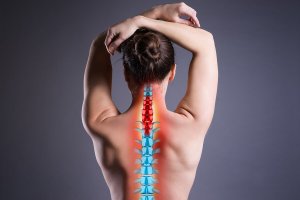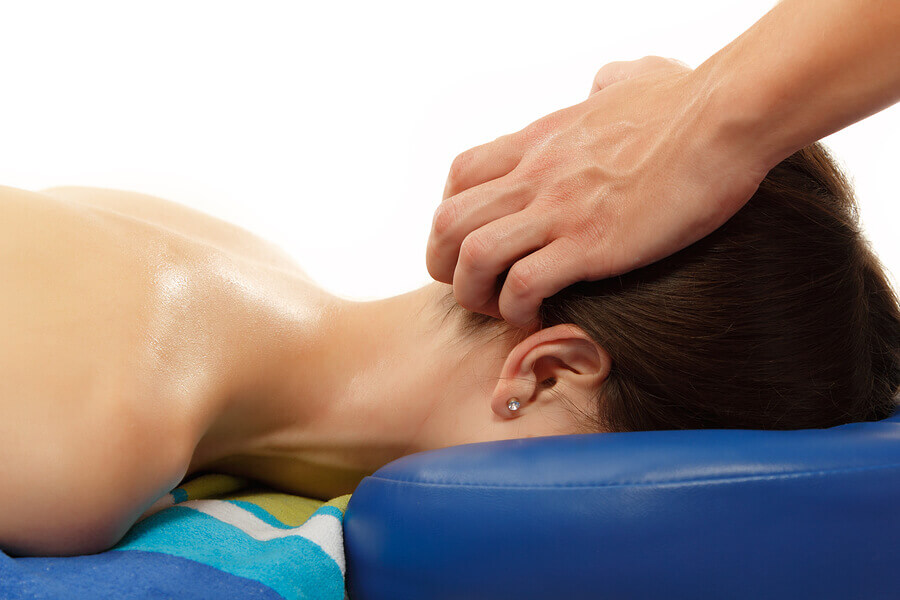Cervical Pain and Three Tips to Treat It

You’ve probably experienced this annoying sensation while working or studying? All of a sudden you feel heaviness or pain in or around your neck or upper back. Although cervical pain has several different causes, the treatment is usually quite simple. In this article, we’ll share a few tips to help you relieve your cervical pain.
Cervical pain
Cervical pain is usually experienced around the neck and upper back (trapezius muscles). There are numerous causes of this type of pain, the following are a few examples:
- Excessive training. Weightlifting, javelin, hammer throwing, and CrossFit are just a few of the sports that demand intense use of the deltoid, trapezoids and rotator muscles.
- Sitting for too long. This is typical for people who spend hours sitting in the same position at the office. These professionals may end up adopting bad posture due to muscular fatigue and the overload of the trapezius muscles.
- Bad posture. This is common in people who suffer from kyphosis, scoliosis and other disorders that affect the spine. If spine deviations are not corrected, cervical pain may occur on a regular basis.
- Muscle cramps caused by excessive strain. This occurs after sleeping poorly and it’s usually caused by sudden movements that hyperextend the muscles in the neck.
- Cervical pain may also be caused by the nervous system (pinched nerves). In these cases, however, it’s best to see your health care professional for a thorough examination.

Tips to treat cervical pain
Although it’s always best to consult with a professional in order to find solutions, sometimes, the pain can be treated easily. In most cases, pain is alleviated within two to three days. If you’re experiencing pain that lasts longer than three days, try the following tips:
Manual therapy and stretching
In most cases, manual therapy isn’t only a great way to alleviate cervical pain, it can also prevent it. When cervical pain is caused by muscular stress, performing self-massage and stretching may help to eliminate the toxins accumulated in the muscle fibers.
Find the area that hurts the most and press down perpendicularly. This helps to increase blood flow and reduce inflammation.
If you don’t know how to perform self-massage or if the pain doesn’t subside, consult with a physiotherapist. These professionals know how to locate and treat cervical pain effectively.
Thermotherapy
Cold therapy is usually indicated for acute pain and heat therapy, on the other hand, is indicated to treat pain that lasted for a few days. Heat, such as through manual therapy, increases blood flow and it also helps to eliminate toxic metabolites. Hot water baths can help to relax muscles.
Anti-inflammatory creams
Anti-inflammatory creams that can be found over the counter in pharmacies can be a very effective way to treat neck pain and strains. Apply these creams two to three times each day in order to reduce the inflammation.

Definite treatment of cervical pain
All the above are useful ways to treat cervical pain by yourself. In most cases, these methods will be all you need to alleviate pain. However, if you experience neck pain frequently or if the pain persists, it may be best to consult with a physiotherapist. They are trained and equipped to use effective techniques and manual therapy to reduce pain.
Physiotherapists sometimes use a technique called acupuncture. This consists of locating the trigger point, which is usually a cramp or a knot and then inserting a very fine needle. This helps to alleviate the cramp, instantly allowing the muscles to relax.
You’ve probably experienced this annoying sensation while working or studying? All of a sudden you feel heaviness or pain in or around your neck or upper back. Although cervical pain has several different causes, the treatment is usually quite simple. In this article, we’ll share a few tips to help you relieve your cervical pain.
Cervical pain
Cervical pain is usually experienced around the neck and upper back (trapezius muscles). There are numerous causes of this type of pain, the following are a few examples:
- Excessive training. Weightlifting, javelin, hammer throwing, and CrossFit are just a few of the sports that demand intense use of the deltoid, trapezoids and rotator muscles.
- Sitting for too long. This is typical for people who spend hours sitting in the same position at the office. These professionals may end up adopting bad posture due to muscular fatigue and the overload of the trapezius muscles.
- Bad posture. This is common in people who suffer from kyphosis, scoliosis and other disorders that affect the spine. If spine deviations are not corrected, cervical pain may occur on a regular basis.
- Muscle cramps caused by excessive strain. This occurs after sleeping poorly and it’s usually caused by sudden movements that hyperextend the muscles in the neck.
- Cervical pain may also be caused by the nervous system (pinched nerves). In these cases, however, it’s best to see your health care professional for a thorough examination.

Tips to treat cervical pain
Although it’s always best to consult with a professional in order to find solutions, sometimes, the pain can be treated easily. In most cases, pain is alleviated within two to three days. If you’re experiencing pain that lasts longer than three days, try the following tips:
Manual therapy and stretching
In most cases, manual therapy isn’t only a great way to alleviate cervical pain, it can also prevent it. When cervical pain is caused by muscular stress, performing self-massage and stretching may help to eliminate the toxins accumulated in the muscle fibers.
Find the area that hurts the most and press down perpendicularly. This helps to increase blood flow and reduce inflammation.
If you don’t know how to perform self-massage or if the pain doesn’t subside, consult with a physiotherapist. These professionals know how to locate and treat cervical pain effectively.
Thermotherapy
Cold therapy is usually indicated for acute pain and heat therapy, on the other hand, is indicated to treat pain that lasted for a few days. Heat, such as through manual therapy, increases blood flow and it also helps to eliminate toxic metabolites. Hot water baths can help to relax muscles.
Anti-inflammatory creams
Anti-inflammatory creams that can be found over the counter in pharmacies can be a very effective way to treat neck pain and strains. Apply these creams two to three times each day in order to reduce the inflammation.

Definite treatment of cervical pain
All the above are useful ways to treat cervical pain by yourself. In most cases, these methods will be all you need to alleviate pain. However, if you experience neck pain frequently or if the pain persists, it may be best to consult with a physiotherapist. They are trained and equipped to use effective techniques and manual therapy to reduce pain.
Physiotherapists sometimes use a technique called acupuncture. This consists of locating the trigger point, which is usually a cramp or a knot and then inserting a very fine needle. This helps to alleviate the cramp, instantly allowing the muscles to relax.
All cited sources were thoroughly reviewed by our team to ensure their quality, reliability, currency, and validity. The bibliography of this article was considered reliable and of academic or scientific accuracy.
- Häkkinen, A., Salo, P., Tarvainen, U., Wirén, K., & Ylinen, J. (2007). Effect of manual therapy and stretching on neck muscle strength and mobility in chronic neck pain. Journal of Rehabilitation Medicine, 39(7), 575–579. https://doi.org/10.2340/16501977-0094
- Kohan, E. J., & Wirth, G. A. (2014). Anatomy of the Neck. Clinics in Plastic Surgery, 41(1), 1–6. https://doi.org/10.1016/j.cps.2013.09.016
- Madsen, B. K., Søgaard, K., Andersen, L. L., Skotte, J., Tornøe, B., & Jensen, R. H. (2018). Neck/shoulder function in tension-type headache patients and the effect of strength training. Journal of Pain Research, 11, 445–454. https://doi.org/10.2147/JPR.S146050
- Neck pain: Overview. (2019). Retrieved from https://www.ncbi.nlm.nih.gov/books/NBK338120/
This text is provided for informational purposes only and does not replace consultation with a professional. If in doubt, consult your specialist.








